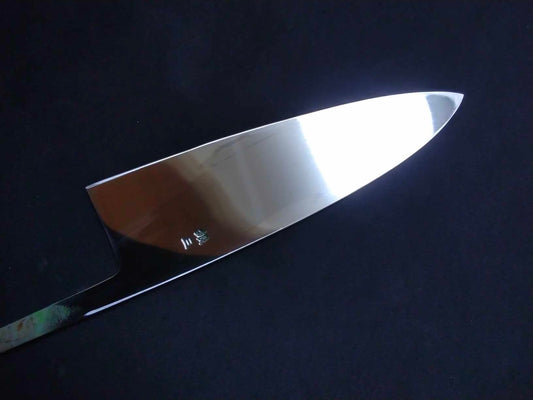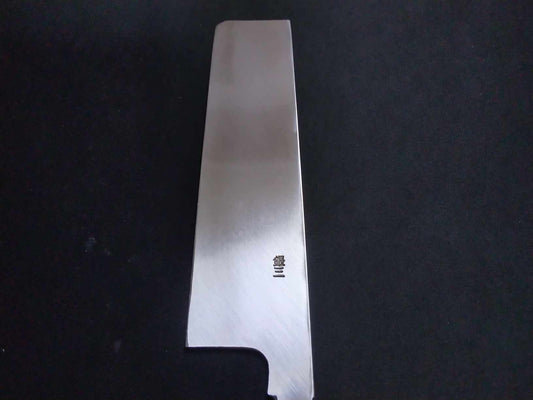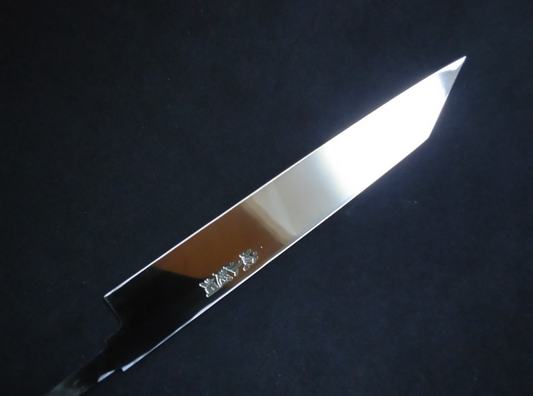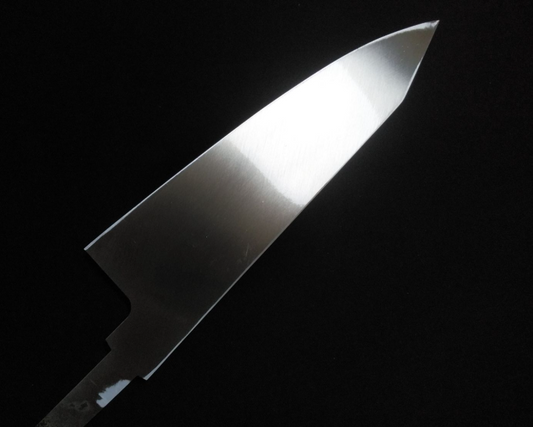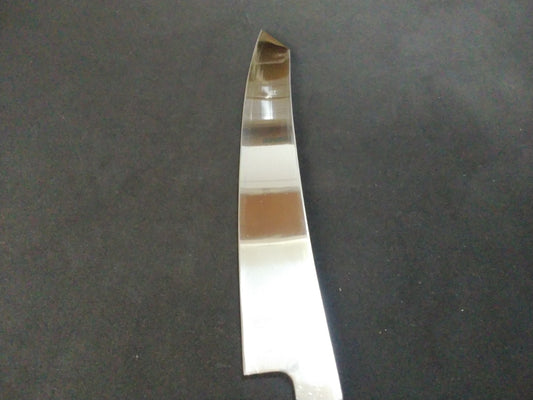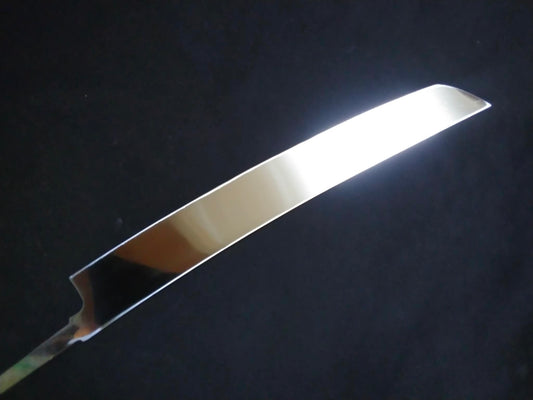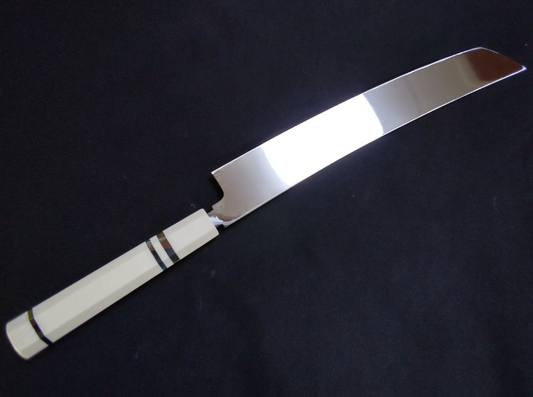
Ginsan
-
The Ultimate Stainless Steel Honoring Tradition and Empowering Today’s Chefs
The saying, “The soul of a knife lies in its steel,” perfectly captures the essence of Ginsan.
Beloved in the world of traditional Japanese knives for decades, Ginsan embodies the very spirit of Japanese craftsmanship by seamlessly combining the sharpness of traditional steel with the corrosion resistance demanded by modern kitchens. -

A Perfect Balance of Carbon Steel Sharpness and Stainless Steel Durability
The greatest appeal of Ginsan lies in its ability to offer the sharpness and ease of sharpening comparable to carbon steel, while firmly maintaining the rust resistance characteristic of stainless steel.
This exquisite balance is a true work of art born from the meticulous adjustments and skill of master artisans. -
Crafted by Skilled Artisans, Delivering Unmatched Sharpness and Texture
Ginsan stands apart from mass-produced steels.
Each blade is carefully forged by experienced craftsmen, painstakingly hammered and stretched to achieve a perfect harmony between toughness and flexibility.
This results in a knife that becomes more comfortable with use, delivering a satisfying rebound and precise control with every cut. -

A Worthy Investment Marked by Time and Craftsmanship
Due to the intensive labor and skill poured into each blade, Ginsan knives are not inexpensive.
However, their price reflects not just the numbers but the advanced forging techniques, the premium materials used, and the invaluable enhancement they bring to a cook’s culinary journey. -
The Perfect Choice For Those Who:
- Wish to incorporate the authentic sharpness and feel of traditional Japanese knives into their daily cooking
- Desire a rust-resistant and easy-to-maintain blade
- Seek a genuine, artisan-crafted knife that represents true quality and passion
Ginsan is the ideal companion for today’s busy chefs who still appreciate and uphold the soul of Japanese blades. -
Ginsan — Honing the Chef’s Skill and Sensibility, Passing Tradition to the Future
As you use it, Ginsan grows richer in character and fits your hand ever more naturally. It is not merely a kitchen tool but a masterpiece imbued with the pride of craftsmanship and a partner that fully amplifies the chef’s expressive potential.
The sharpness felt with each cut represents the ultimate partnership in the art of cooking.
Ginsan is the blade that opens new possibilities and brings joy to your culinary creations—truly a knife that shapes the future.
Ginsan Japanese Knife Collection
Authentic Japanese Knives, Shipped Worldwide from Sakai.
More details: Global Delivery from Sakai
-
Ginsan Deba 180mm -Mirror Polished(both sides)
Regular price $403.00 CADRegular priceUnit price / per$0.00 CADSale price $403.00 CADSold out -

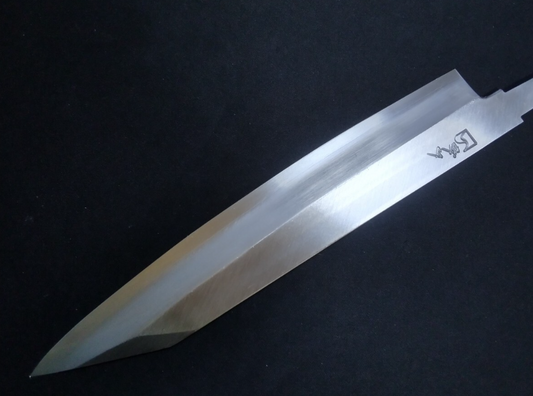 Sold out
Sold outGinsan Gyuto 240mm -Kido Finishing
Regular price $410.00 CADRegular priceUnit price / per$0.00 CADSale price $410.00 CADSold out -
Ginsan Usuba 210mm -Mirror Polished(one side)
Regular price $412.00 CADRegular priceUnit price / per$0.00 CADSale price $412.00 CADSold out -
Ginsan Yanagiba(Kiritsuke) 225mm -Mirror Polished(both sides)
Regular price $412.00 CADRegular priceUnit price / per$0.00 CADSale price $412.00 CADSold out -
Ginsan Gyuto 210mm -Mirror Polished(both sides)
Regular price $430.00 CADRegular priceUnit price / per$0.00 CADSale price $430.00 CADSold out -
Ginsan Deba 210mm -Mirror Polished(one side)
Regular price $430.00 CADRegular priceUnit price / per$0.00 CADSale price $430.00 CADSold out -
Ginsan Gyuto (Kiritsuke) 240mm -Kido Finishing
Regular price $460.00 CADRegular priceUnit price / per$0.00 CADSale price $460.00 CAD -
Ginsan (Honyaki) Gyuto 210mm -Mirror Polished(both sides)
Regular price $615.00 CADRegular priceUnit price / per$0.00 CADSale price $615.00 CADSold out -
Ginsan (Honyaki) Gyuto 240mm -Mirror Polished(both sides)
Regular price $655.00 CADRegular priceUnit price / per$655.00 CADSale price $655.00 CADSold out -
Ginsan (Honyaki) Gyuto 270mm -Mirror Polished(both sides)
Regular price $685.00 CADRegular priceUnit price / per$685.00 CADSale price $685.00 CADSold out -
Ginsan (Honyaki) Yanagiba 270mm -Mirror Polished(both sides)
Regular price $710.00 CADRegular priceUnit price / per -
Ginsan Damascus Yanagiba(Kiritsuke) 270mm -Mirror Polished(both sides)
Regular price $740.00 CADRegular priceUnit price / per$0.00 CADSale price $740.00 CAD -
Ginsan Damascus Yanagiba(Sakimaru) 300mm -Mirror Polished(both sides)
Regular price $810.00 CADRegular priceUnit price / per$0.00 CADSale price $810.00 CAD -
Ginsan (Honyaki) Yanagiba (Sakimaru) 270mm -Mirror Polished(both sides)
Regular price $960.00 CADRegular priceUnit price / per$685.00 CADSale price $960.00 CAD -
Ginsan (Honyaki) Yanagiba(Sakimaru) 300mm -Mirror Polished(both sides)
Regular price $1,000.00 CADRegular priceUnit price / per -
Ginsan Damascus Yanagiba(Sakimaru) 400mm-Mirror Polished(both sides)
Regular price $1,180.00 CADRegular priceUnit price / per$0.00 CADSale price $1,180.00 CAD
KIREAJI's Three Promises to You
-

1. Exceptional Japanese Knives
Our knives, crafted by Sakai City's master artisans, combine traditional techniques with carefully selected materials, delivering unrivaled sharpness and durability.
-

2. For a Lifetime of Use
At KIREAJI, we see knives as lifelong companions. Each knife comes with a free saya, and we offer Honbazuke hand-sharpening by Shiroyama Knife Workshop in Sakai City.
-

3. Supporting the Joy of Continued Use
KIREAJI knives are made to grow with you. That’s why we provide trusted after-sales care (fee-based) .
-
Ginsan Steel: The Ideal Knife Material Blending Tradition and Innovation
-
-

What is Ginsan?
Ginsan, produced by Hitachi Metals, is a stainless steel known for its rust resistance, sharpness, and durability. It offers carbon steel-like cutting performance and is highly valued in Japanese culinary craftsmanship. Hitachi Metals also produces other high-quality steels like White Steel and Blue Steel. Ginsan boasts sharpness comparable to carbon steel, while alleviating the common challenge of sharpening associated with stainless steel, and it reduces slipping when cutting food.
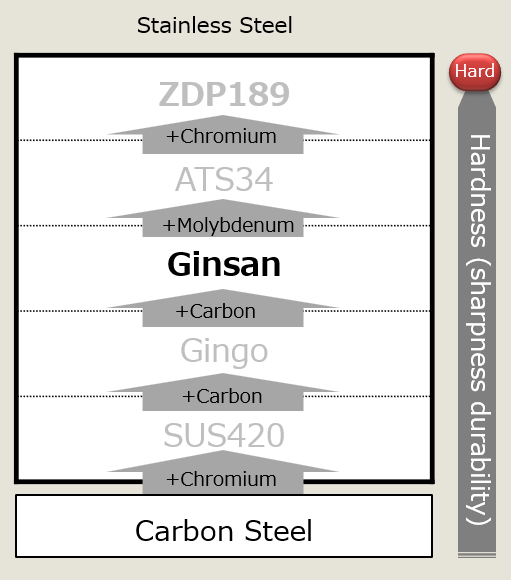
Ginsan’s balance between corrosion resistance and cutting performance makes it an excellent choice for knife materials. With a high chromium content of 13-16%, it offers strong resistance to corrosion, while its carbon content ranges from 0.8 to 1.3%, striking a balance between hardness and toughness to ensure stability during use.
Because of its superior sharpness and resistance to rust, Ginsan is extensively used in kitchen knives, trusted by both professional chefs and home cooks alike. It enhances daily culinary tasks, making them more efficient and enjoyable.
Features of Ginsan
-

Comparable Sharpness to Carbon Steel
Ginsan is a material with high carbon content and exceptional hardness. When sharpened, it exhibits sharpness comparable to steel knives.
-

Most Sharpenable Among Stainless Knives
With a hardness of around HRC 60, similar to carbon-based Japanese knives, Ginsan mitigates the typical difficulty of sharpening associated with stainless steel, making it relatively easy to handle even for beginners.
-

Rust-Resistant with Minimal Food Adhesion
Ginsan knives are highly resistant to rust and offer minimal food adhesion while cutting. This makes them a favorite among Japanese culinary craftsmen.
-
Recommended Users for Ginsan
-
- For those seeking a rust-resistant knife: Ginsan is highly resistant to rust, similar to regular stainless steel, making it ideal for those who want low-maintenance knives.
- For those who prioritize sharpness: Ginsan offers sharpness comparable to carbon steel and has high hardness, making it perfect for those who value a razor-sharp edge.
- For those looking to overcome the drawbacks of stainless steel knives: Ginsan is easier to sharpen than regular stainless steel knives and is known for less drag when cutting ingredients.
-
In conclusion, Ginsan steel is a well-balanced knife material that combines rust resistance, superior sharpness, and ease of sharpening. Its unique ability to be enhanced through hammer forging distinguishes it from other stainless steels, making it a truly innovative material that leverages traditional Japanese blade-making techniques.
-
The True Value of Ginsan Unleashed Through Forging
-
Ginsan is renowned not only for its exceptional sharpness but also for its ease of sharpening and long-lasting edge retention, making it an extremely well-balanced blade steel. However, superior material alone does not create an outstanding knife. The true key to unlocking Ginsan’s full potential lies in the craftsman’s forging technique.
-
Unlike most stainless steels, which only change shape through forging but do not significantly improve in strength, Ginsan shares a composition similar to carbon steel. This allows it to benefit from hammer forging, which enhances overall blade strength, extends edge retention, improves sharpenability, and reduces chipping.
-

-
When a skilled craftsman repeatedly hammers the blade using a belt hammer, it breaks down and evenly distributes the carbon structure throughout the steel. This process transforms Ginsan into a blade that rivals White #2 steel in sharpness and toughness, setting it apart from other stainless steels.
-
Moreover, Ginsan does not contain Molybdenum (Mo), Nickel (Ni), Vanadium (V), or Tungsten (W), which are common in most stainless steels. As a result, it is known as "stainless steel that sharpens like carbon steel." This unique characteristic allows users to experience the true essence of craftsmanship every time they sharpen and use the knife.
-
However, due to these exceptional properties, the quality of a Ginsan knife is highly dependent on the precision of the forging process. In regions like Seki City, where hammer forging is less common, Ginsan is rarely used because it requires a masterful forging technique to reach its full potential.
-
Ultimately, Ginsan’s true value is determined by the craftsmanship that refines it. Knives forged with traditional hammer techniques offer an unparalleled balance of sharpenability, cutting performance, and durability—a blade that becomes even more remarkable the more you use it.

Japanese Knife Materials
In the realm of Japanese knives, the choice of material plays a crucial role in performance and maintenance. This guide delves into the nuances of carbon and stainless steel, including popular variants like White Steel #2 and Blue Steel #2, and newer innovations like ZDP189 and Ginsan.

Ginsan – The Fusion of Tradition and Modern Technology
Ginsan is a premium stainless steel widely used in Japanese knives, offering the perfect balance between razor-sharp edges and rust resistance. Unlike most stainless steels, Ginsan shares characteristics with carbon steel, making it easier to sharpen while maintaining long-lasting performance. Additionally, its unique composition allows forging to enhance its strength and durability, setting it apart from conventional stainless steels. This makes Ginsan knives an ideal choice for both professional chefs and home cooks who seek superior cutting performance with minimal maintenance.
FAQ About Ginsan

What are the components of Ginsan?
Ginsan is a stainless steel developed by Hitachi Metals, which increases its hardness by increasing the carbon content.
What are the features of Ginsan?
- Comparable sharpness to steel
- Easiest to sharpen among stainless knives
- Resistant to rust, with minimal food sticking
How are Ginsan knives made?
While typical stainless knives are made by punching steel sheets, Ginsan knives are distinctive for being hand-forged, allowing for manual shaping and forging.
What are Ginsan knives suitable for?
They are favored primarily by artisans in Japanese cuisine due to their exceptional sharpness and durability, making them versatile for various tasks.

The Origin of Craftsmanship
-
Why Ginsan Knives are the Choice of Craftsmen: Sharpening Ease, Sharpness, and the Perfect Harmony with Japanese Cuisine
Ginsan knives are chosen time and time again by craftsmen because they offer a unique blend of sharpness, ease of sharpening, and an exceptional fit with Japanese culinary traditions. The sharpness is immediate, offering a clean, effortless cut, while the ease with which the blade can be restored to its original state after use makes it a preferred choice for professionals.
-
But what truly sets Ginsan apart is how it complements the delicate art of Japanese cooking. The balance between the blade’s durability and its ability to slice through ingredients with precision makes it ideal for preparing dishes that demand attention to detail. Whether it’s the perfect cut of fish for sushi or the delicate preparation of vegetables for kaiseki, Ginsan excels in enhancing the experience.
-
Crafted with care and expertise, a Ginsan knife isn't just a tool; it's a connection to the tradition of Japanese craftsmanship, a true companion in the kitchen for those who value both performance and heritage.
-
Misleading Claims to Watch Out for When Choosing a Stainless Steel Knife
-
"Made from the same material as surgical scalpels."
At first glance, this statement may sound impressive, but it requires closer scrutiny. The stainless steel used for surgical scalpels is often of mid-range or lower quality compared to steels used for high-performance kitchen knives.
The primary requirements for surgical scalpels are hygiene and corrosion resistance, whereas kitchen knives need long-lasting sharpness and ease of sharpening. In this regard, scalpel-grade steel is not necessarily ideal for knives.
Moreover, many surgical scalpels are disposable and not designed for long-term use or resharpening. Just because a knife is made from the same material as a scalpel doesn’t automatically mean it’s a high-quality kitchen knife. It’s important to be cautious of such claims when making a purchase. -




